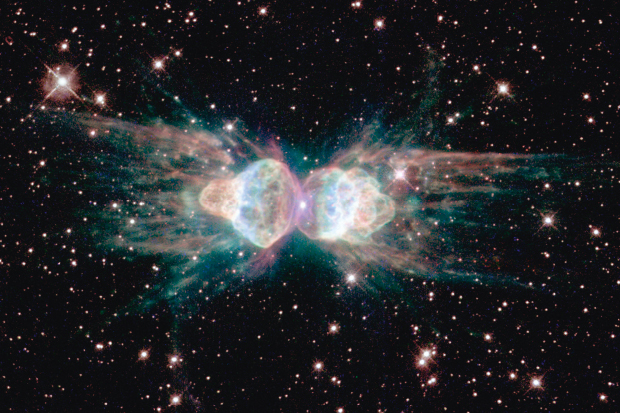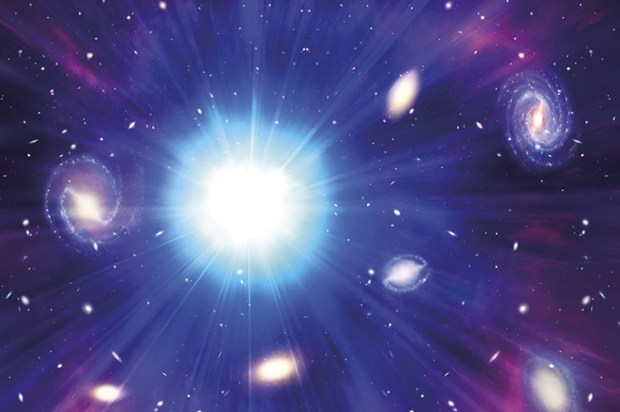Physicists have a nerve. I know one (I’ll call him Mark) who berates every religious person he meets, yet honestly thinks there exist parallel universes, exactly like our own, in which we all have two noses. He refuses to give any credit to Old Testament creation myths and of course sneers at the idea of transubstantiation. But, without any sense of shame, he insists in the same breath that humans are made from the fallout of exploded stars; that it is theoretically possible for a person to decompose on one side of a black hole and recompose on the other, and that there are diamonds in the sky the size of the moon.
The Universe in Your Hand by Christophe Galfard, a young French theoretical physicist and former student of Steven Hawking, is subtitled ‘A Journey Through Space, Time and Beyond’. It could just as well have been called a journey through common sense into preposterousness. ‘A popular science book that aims to explain Quantum Mechanics, General Relativity, String Theory and Parallel Realities using storytelling instead of graphs and equations,’ declares the blurb. Since I last studied physics, as an undergraduate in the 1980s, the subject has lost all pretence of good behaviour: it is now much kookier than anything in the Bible. It took me a week to read The Universe in Your Hand and two weeks to recover from my outrage. My friend Mark’s hypocrisy is immeasurably deeper than I’d realised.
The book opens with a Doom. Picture yourself lying on a beach, begins Galfard, ‘on a faraway volcanic island on a warm cloudless summer night’ — ‘the surrounding ocean is as still as a lake’ and ‘you remember questions you had as a child: what are they, these stars? Why do they flicker? Why should we care?’
For a page and a quarter Galfard lilts along in this soothing tone. ‘Your friends will soon be joining you for a drink.’ ‘A tiny shooting star gently streaks across the sky’. Suddenly, boom!, the next thing you know, you are no longer on the beach but in outer space, floating through emptiness…. A few hundred thousand miles ahead, a ball is flying against a background of tiny distant stars. It is a liquefied planet.
Our sun is about to burst. The liquefied planet is us. Galfard’s style becomes cinematic, staccato, informative, thrilling, poetic. We are going to witness ‘one of the most violent events the universe can provide’, a thing ‘of monstrous beauty’. As the sun swells, ‘huge filaments of million-degree hot plasma blast through space’ and the liquefied planet, ‘pounded by energies beyond its strength, is blown into nothingness’. The sun ‘does not even notice and then, quite suddenly, it explodes, firing all the matter it was made of into outer space.’ The entire event is silent, ‘for sound does not spread in the vacuum of space’.
In the foreword to his book, Galfard writes: ‘Before we start, there are two things I would like to share with you. The first is a promise, the second is an ambition.’ His promise is ‘never to use any other equation apart from E=mc2.’ His ambition is that ‘in this book I will not leave any readers behind’. He honours both; without mathematics, he manages to make his mathematical subjects feel possible for ordinary readers to think about in non-trivial ways; without trivialising, he is clear and never gets entangled (as so many other popular physics books do) in frenetic passages of jargon and big numbers.
After our first ‘journey’, to witness the dying sun, Galfard returns us with a thud to our tropical beach and adopts his pastoral cooing tone again, like a dove in the church eaves. We must learn about the universe if we’re going to survive this catastrophe, which means going on more guided journeys through spacetime with Dr Galfard. We’d better hurry. We’ve got only 420 pages and five billion years to go.
The rest of Part I of The Universe in Your Hand (there are six parts in all, each covering different aspects of either quantum physics, relativity theory or cosmology) takes us through the cosmos and beyond the Milky Way until we have reached what Galfard calls ‘the First Wall at the End of the Universe’, 13.5 billion light years from earth, ‘a place that is not for light to travel through’. Part II, ‘Making Sense of Outer Space’, introduces general relativity and explains what the First Wall tells us about the origin and growth of the universe. It is in Part III, ‘A Dive into the Quantum World’, that Galfard starts to lose his sanity.
If the fundamentalists of the American Midwest want to advance exegesis, they should send their preachers to MIT. Parallel worlds; entire universes smaller than the size of a subatomic particle; the fact that there is real, visible evidence that all possible existences (some of which would have led to the worlds of two noses) were at one stage frozen in time, and that this evidence comes from looking up at the sky when sitting on a sunlounger in the middle of the Pacific Ocean; that there are universes inside universes inside universes, encased like bubbles … all this, says Galfard, ‘may (and should) sound completely crazy to you (it does to me, but I like it)’; yet there are sound and consistent arguments, each built out of the basic ideas of GCSE physics, to justify every word.
Quantum fields are not unlike agricultural ones: they are continuous landscapes in which crops can spring up anywhere. Just as different fields of the countryside grow different produce — steep fields for sheep, drained fields for wheat — different quantum fields grow different particles. The electromagnetic field grows electrons and photons. The strong nuclear force field grows quarks and gluons. One critical difference between agricultural fields and quantum ones is plenitude. Whereas Britain supports several million fields, the universe supports four. All this is well established, repeatedly proved by long equations and backed up by multi-billion dollar experiments in the subterranean particle-smashing tubes at Cern. Gravity is another field and, since there’s no point having a field unless you can produce something on it, gravitational fields grow gravitons.
Only they don’t.
No matter how hard the theoretical farmers of mathematics try, they cannot make gravity produce gravitons without sending the whole of quantum theory into oblivion. Experimentalists have also never spotted a graviton. Places such as Cern are the Defra of physics. Their job is to confirm what particles are growing in which fields, and the gravitational field is looking increasingly like a Brussels subsidy scam.
Hemmed in by inconsistencies, badgered by paradoxes, aware that soon something somewhere must give and result in a new theoretical evangelism, physicists have proposed extraordinary ideas. Galfard guides us around many of them with calmness and good humour. His style is occasionally annoying. Now and then he overdoes the gently guiding, avuncular-vicar tone and sounds more like a physics graduate trying to chat you up in the pub; but, somehow, against all my desire to be grumpy about it, it eventually works.
On the last ‘journey’, Galfard takes us outside the universe in the company of a small talking robot. Exiting our universe is allowable, according to the latest, and currently most successful, attempt to unite gravitation with quantum fields — String Theory. Strings are vibrations of nothingness, ‘like the blur of a guitar string without the string itself’. A billion billion billion times smaller than the width of a human hair, each string is capable of giving rise to a universe. String theorists call these universes ‘branes’. Out of nothing comes everything, and our universe is a brane.
If my friend Mark emits a peep of complaint about the modest idea of a god or the myths of Genesis the next we meet, I’m going to be down on him like a ton of exploding suns.
Got something to add? Join the discussion and comment below.
Get 10 issues for just $10
Subscribe to The Spectator Australia today for the next 10 magazine issues, plus full online access, for just $10.
Available from the Spectator Bookshop, £12.99 Tel: 08430 600033. Alexander Masters is the author of The Genius in My Basement, a biography of the mathematician Simon P. Norton.
You might disagree with half of it, but you’ll enjoy reading all of it. Try your first month for free, then just $2 a week for the remainder of your first year.














Comments
Don't miss out
Join the conversation with other Spectator Australia readers. Subscribe to leave a comment.
SUBSCRIBEAlready a subscriber? Log in